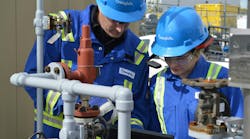BULKHEAD: A tank-to-plumbing connection that makes the transition through the tank wall and a liquid-tight seal.
CAPACITY: The maximum amount of liquid a tank can contain.
CONICAL: Storage tanks that are not flat-bottomed and contain a degree of slope are often referred to as conical or dish-bottomed.
CONTAINMENT: An area that is used to capture liquid in the event of a spill or leak from a storage vessel.
CROSS-LINK: Type of polyethylene that is industrial grade, where the polymer chains are linked together. This material is used to construct large chemical storage tanks.
DOUBLE-WALL: A type of storage tank that has both a primary vessel and a secondary containment basin that are assembled. Double-wall tanks are used to contain liquid that would be hazardous to the environment in the event of a spill.
FLANGE: Type of connection commonly found on storage tanks and vessels. Flanges are also used through most network piping.
FULL DRAIN OUTLET: Provides the ability to fully drain a tank without the need for mechanically installed nozzles.?
HORIZONTAL: Storage tanks that are configured to be installed on their side rather than in a vertical position are often referred to as horizontal tanks.
LIFTING LUGS: Items that are used to assist in positioning of a tank.
LINEAR: Often referred to as conventional polyethylene. Linear polyethylene is used in agricultural storage tanks and also food-grade storage applications.
POLYETHYLENE: The most common plastic used in the United States. This material is used for anything from children’s toys to chemical storage tanks.
RESERVOIR: Storage area that is commonly found to hold liquid. Often referred to at an artificial lake or impoundment.
REVERSE FLOAT LEVEL: A system that shows the liquid level in the tank by utilizinga float that rides on the liquid that is contained within.
ROTO-MOLDING: The method used for creating chemical storage tanks and containers. Polyethylene is liquefied in a hollow cavity mold that is rotated on two axes, then cooled to solidify the plastic.
SIGHT GAUGE: This is a fitment that attaches to a storage tank and assists in measuring the amount of liquid contained within a tank.
VALVE: A device that regulates, directs or controls the flow of a fluid (gases, liquids, fluidized solids, or slurries by opening, closing, or partially obstructing various passageways.
VENT: Plumbing or drainage commonly used to allow tanks or reservoirs to relieve gases and fumes into the atmosphere.
Assmann Corporation of America (www.assmann-usa.com), a manufacturer of polyethylene tanks and containers, provided the terms and definitions for this word search.

